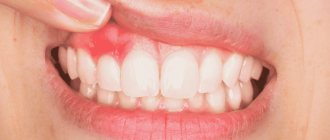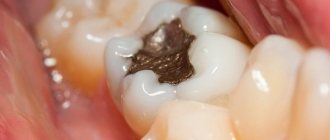30.05.2019
Progress does not stand still! It is with this obvious truth that I would like to begin today’s article. This applies to all areas of our lives, and by a happy coincidence, dentistry included! Every year, more and more new materials enter the dental market: safer, more aesthetic, and more practical to use. A constantly developing dentist now has in his arsenal high-tech devices and modern materials that allow him to provide high-quality, comfortable, and most importantly, safe dental care.
However, this was not always the case. Just some 10-15 years ago, treatment methods were still actively used that were not only unaesthetic, but also far from safe. The most striking example of this is amalgam fillings.
In historical essays, fillings similar in composition began to be used more than 100 years ago. Amalgam was an alloy of various metals, such as mercury, silver, tin, zinc, copper, etc.
The creation of such a material was made possible thanks to the ability of mercury to dissolve other metals in itself.
Example of an amalgam filling (work taken from the Internet)
Its main advantages were considered to be: strength, lack of visible abrasion and chipping, antiseptic properties of silver, and the ability to inhibit the progression of caries. The last point is very controversial, because under amalgam fillings, in the vast majority of cases, we find a recurrence of caries.
Obvious disadvantages include:
- Low aesthetic characteristics (metallic colored filling);
- Inability to restore the anatomical shape of the tooth (cusps and fissures);
- High thermal conductivity (increased sensitivity when eating cold and hot food);
- Technical difficulties at work.
And last but not least -
- Constantly released mercury vapor into the oral cavity.
The last point is now being studied especially carefully. After all, scientists have proven that mercury is a heavy metal that cannot be eliminated from the body on its own. Moreover, it has a destructive effect on human nerve cells. And if the patient has amalgam fillings in the oral cavity, on the side teeth, the structural elements of these fillings permanently enter the human body. Thus, chronic toxic effects of heavy metals occur.
Doctors all over the world have recognized the harm of amalgam and not only refused to place such materials, but also urgently recommend getting rid of such fillings.
Relatively recently, in the United States, the dental association created standards for the safe removal of amalgam fillings. This is called the SMART protocol. The essence of this protocol is that it is necessary to minimize the contact of the removed filling with the body of the patient, as well as the doctor and assistant.
Main advantages
The material turns out to be very plastic, and therefore easy to apply and simple to work with. After free mercury is released, it hardens on its own, meaning restoration does not require the use of expensive equipment.
What other advantages are there due to the composition:
- high strength and wear resistance, ability to withstand any chewing loads,
- long service life: from 10 years or more with careful care,
- possibility of installation in a damp tooth cavity,
- anti-corrosion properties,
- antibacterial effect,
- preservation of shape and color,
- good penetrating ability: in the presence of zinc in the composition, it penetrates well into small cracks in hard tissues and seals them,
- high radiopacity.
To do this, the following requirements must be met:
- The skin, hair, and clothing of the patient and medical staff must be carefully covered.
- The seal is drilled with a special bur that does not create dust, with the supply of a large amount of water.
- The procedure for removing amalgam fillings is performed in a rubber dam using a hood or vacuum cleaner.
- It is necessary to ventilate the office after this manipulation.
The process of removing an amalgam filling (example provided from the Internet)
All these conditions must be observed, because during the removal of the filling, toxicity increases tenfold.
Important information! Patients during pregnancy and lactation should avoid removing amalgam fillings to avoid negative effects on the child’s body.
At the Atribeaute Clinique aesthetic dentistry department, strict monitoring of compliance with the SMART protocol is carried out. After excision of amalgam fillings, we carry out restoration with a composite material that can completely restore the aesthetic and functional characteristics of the tooth, while remaining 100% safe and hypoallergenic for the entire period the restoration is in the oral cavity.
Tooth restoration with Enamel composite material (the work of dental therapist Tamara Valerievna Kudzieva)
Is it worth changing an amalgam filling?
Some experts believe that amalgam fillings should be completely replaced with modern composite materials. However, any repeated tooth irritation may do more harm than good. Therefore, fillings are changed only in some cases.
Indications for replacing amalgam fillings
- Caries developing around a filling.
- Large fillings (amalgam fillings are not suitable for reconstruction of large cavities).
- Weakened teeth. If only thin walls of the tooth remain, amalgam can cause them to crack.
- Replacement of an amalgam filling for aesthetic reasons, as its color differs from the natural color of the tooth.
There are several situations when it is advisable not to replace amalgam fillings with composite ones. These are usually small fillings that are placed correctly. Any intervention can lead to later complications, so only a doctor can say for sure whether the filling is worth changing.
Contraindications for installation
The material is not used if the patient has an individual intolerance to metals and a tendency to allergic reactions. This restoration option is not suitable if you already have structures made of solid metal and metal-ceramics installed in your mouth, and also if you want to restore your front teeth.
Important! Since 2022, the use of amalgam filling material in dental treatment for pregnant and lactating women and children under 15 years of age has been prohibited in the European Union.
Cement composites
Dental cement (silicate cement, phosphate cement, zinc sulfate cement, etc.) is a time-tested material for filling teeth. Some varieties are used for the superficial layers of dentin, others for the deep ones. They are inexpensive, reliable and absolutely safe. They are the ones most often used in the treatment of children. Silicate cement is similar in color and transparency to natural enamel and is strong enough to withstand the loads of the front teeth.
The disadvantage of cement composites is their increased density. Over time, the hardened material destroys surrounding tissue, contributing to the development of secondary caries. Most often it is used to create a temporary filling for a tooth.
Types of amalgam
Doctors use different amalgams to fill teeth. They differ in the concentration and ratio of metals in the composition. Some types contain a lot of silver and very little copper (less than 6%) - this is called silver amalgam in dentistry. In others, on the contrary, copper predominates - it can account for up to 30-37% - this variety is called high-copper and is considered the most advanced of the existing ones. There are options with and without zinc, as well as with the inclusion of expensive and rare metals (palladium, platinum).
Photo: mercury amalgam fillings
Read the article on the topic: types of dental fillings. Find out which ones are considered the best today.
A few words about components and properties
The material is obtained by dissolving metal alloys in mercury. The finished substance is moderately plastic, which allows you to accurately recreate the shape of the future filling. Free mercury gradually disappears and the material hardens. Sufficient strength for constant chewing load is achieved only after a day. The composition contains the following main substances:
- silver – prevents the spread of corrosion and provides high strength,
- tin – partly responsible for plasticity, prolongs the hardening process,
- copper – has anti-corrosion properties and provides an additional antibacterial effect,
- zinc – softens other components,
- Mercury – represents the main trigger or reactant.
The material contains many different metals.
In professional medical terminology, there is a definition that describes the chemical reaction of mercury leading to the formation of an amalgam - mechanochemical synthesis1.
Use of ceramics
Ceramics are quite hard and do not change color or size over time. This explains its popularity in dentistry. Filling carious holes with ceramics does not occur immediately in the patient’s mouth. First, impressions are taken of both jaws, then individual inlays are made, which are securely attached to the recesses.
Restoring crowns with ceramic inlays takes longer than any other, but the results are worth it. The inserts stay in place perfectly, and the tooth under such a filling experiences a uniform load. Ceramic materials can have different compositions.
Used in dentistry for about 200 years
It is known that amalgam dental fillings were invented a long time ago. The first mentions of it are found in the documentation of the Middle Ages. However, specialists began to use it widely and everywhere only in 1855. It was then that its composition was first patented and then improved by American dentists.
What you need to know about amalgam fillings
Until the early 2000s, dentists in Europe, the USA, the Soviet Union and the Russian Federation actively placed amalgam fillings on teeth. Later, a number of studies appeared that proved the harm and toxicity of the material, which is why many doctors stopped using it in their practice, and some countries even banned the use of amalgam.
Glass ionomer cement
A glass ionomer filling is considered temporary, but it is very durable and adheres tightly to the tooth. It replaced the classic types of dental cements. The material does not allow achieving the required level of aesthetics, therefore it is used as a spacer under the polymer.
The main advantage of glass ionomer cement is the presence of fluoride in its composition. Thanks to this, tooth tissues are strengthened, acquiring increased protection against caries. The material can be self-hardening and light-curing.
Additional Information. The use of glass ionomer cement is widespread in pediatric dentistry. This gentle material is used to install a permanent filling for a child.
Important!
Composition of modern amalgams:
- silver (66–73%), provides strength and resistance to corrosion, causes expansion when hardening;
- tin (25–29%), increases the plasticity of amalgam;
- copper (2–6%), gives strength and ensures that the filling adheres to the edges of the cavity, also has antibacterial and anti-corrosion properties;
- zinc (up to 2%), reduces the oxidation of other alloy metals;
- mercury (up to 3%), the main reagent, solvent, causing the formation of amalgam.
Amalgam was sent for MRI
But almost simultaneously with reports of regulation of the use of amalgam fillings in Europe, data from Turkish scientists appeared. And this time we were talking about the direct effect of the mercury they contain on the human body.
A laboratory experiment was conducted. Teeth with amalgam - removed, of course - were placed in a test tube with saliva and exposed to a magnetic field, as in an MRI. After exposure to a magnetic field of 1.5 tesla (this is what is used now in most tomographs), there was no significant increase in the mercury content in saliva. But in those test tubes that were exposed to a magnetic field of 7 Tesla, five times more mercury was released. Devices with such a powerful magnetic field are already used in laboratory research, but there are almost none in hospitals. True, their introduction into everyday practice is just a matter of time.
Scientists have not yet expressed a categorical opinion on how dangerous the release of mercury into saliva during MRI is. To do this, you still need to know how much of it can stay in the body.
Research will continue. And their benefits are undoubted. One hundred and fifty years of practical use of amalgam is a good argument. But our living conditions and technologies are changing. And what some time ago did not pose any danger can now manifest itself in unexpected ways.
How to remove a filling and replace it
Removing filling material requires very careful cleaning of the cavity and complete disposal of used raw materials. A drill is not suitable for this - the seal is cut crosswise, after which it is carefully removed in parts. Instead of a diamond bur, special steel cutters are used. The surrounding space must be isolated with a rubber dam.
All seized items are placed in a sealed case and disposed of in accordance with established regulations. However, it is not recommended to remove the filling during pregnancy and breastfeeding. In all other cases, experts advise taking activated charcoal and vitamin C before removing or replacing.
How filling is carried out - description of the process in stages
The installation of an amalgam filling can be divided into several independent stages. Let's take a closer look at this sequence:
- preparatory measures: this includes cleaning the teeth from plaque and stone, administering anesthesia and fixing the rubber dam. Next, the doctor prepares the carious cavity, removes all affected tissue and carries out disinfection treatment. In this case, the thickness of the tooth walls should be slightly greater than required when filling with modern composites. A small cut should be left at the junction of enamel and dentin to improve retention. The tooth is washed and dried,
- application of a gasket: required to reduce tooth sensitivity, which can develop due to the increased thermal conductivity of the material. Its optimal thickness is 1-1.5 mm,
- amalgam mixing: carried out mechanically using a special electric mixer,
- installation of a filling - amalgam is applied in small layers using a special gun, waiting until it completely condenses before the next application. It is important to prevent the material from becoming porous and to remove all excess mercury. The cavity is filled, after which the edges are carefully removed, immediately forming a preliminary crown shape.
The amalgam is applied in small layers.
The final modeling of the restored area involves the application of tubercles and fissures. After this, occlusion control is required, for which special articulation paper is used. The filling itself is ground and polished only after a day. In this process, it is important to prevent overheating and evaporation of mercury, so water cooling is usually used.











